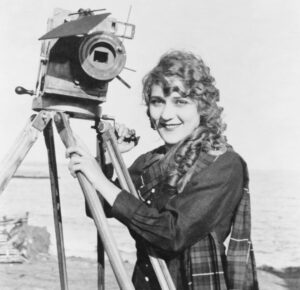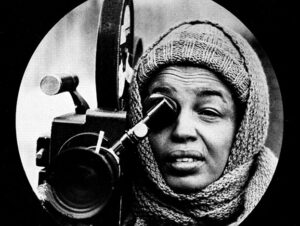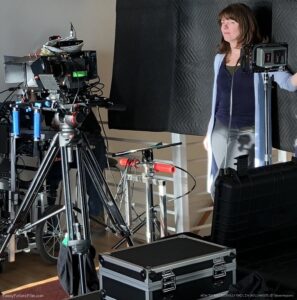by C.M. Conway
When embarking on a journey to make my first film, I studied the history of women filmmakers and discovered a hidden treasure: a large society of prolific female filmmakers before the era of “talkies.”
In fact, the silent film industry was led by women producers, directors, writers and actors (many multihyphenates). We owe a great debt to them, as they pioneered the way to form the foundations of the art and craft of cinema.
The careers of many of these women soured when sound was introduced in movies. Theories abound as to why this occurred, ranging from the director-orientated system transitioning to studio-orientated; to good old-fashioned capital and the industrialization of movies. In an article from the 1920s, Terry Ramsaye was quoted in Photoplay stating, “Every element of the creative side of the industry is being brought under central manufacturing control.”
Mary Pickford’s contributions to silent film are well documented, and she’s one of its

most recognizable faces. In 1916, Pickford not only starred but had full reign over the making of her numerous films. In 1919, Pickford, D.W. Griffith, Charlie Chaplin, and Douglas Fairbanks gathered to form United Artists, adding distribution to Pickford’s versatility.
But hidden in history are the stunning contributions of a worldwide community of female filmmakers in silent film, a sample listed below. Countless left established studios and founded self-named companies and did it all: acting, writing, producing and directing. Some partnered with their husbands in forming companies. All broke barriers.
Lois Weber was a major director and producer at her own company and made over 400 films.
Gene Gauntier was an influential actress and writer who co-founded a company. Wrote the first script of Ben-Hur.
Flora Flinch was an actress and director of her own films. Made 250 shorts with John Bunny.
Cleo Madison was a writer and director at Universal Films.
Ann Brody (Goldstein) was a groundbreaking film actress. Performed on stage over 50 years.
Mabel Normand was an actress, writer, director and founder of her own company. She was a major influence on Charlie Chaplin and the early Keystone comedies.
Marion Leonard acted with Mary Pickford and one of the first actresses to be billed on screen.
June Mathis wrote over a hundred produced screenplays, the first female executive at Metro Pictures and a founding member of the Academy of Motion Picture Arts and Sciences.
Texas Guinan was an actress, producer and considered the first cowgirl in movies.
Dorothy Davenport Reid was from an entertainment family and produced, directed, wrote and formed her own production company. She notably employed female writers.
Alla Nazimova was a skilled actress born in Crimea, producing risky and experimental work.
Marion E. Wong was a Chinese American actress, producer, director and screenwriter who founded her own production company in Oakland.
Beatriz Michelina was a Mexican actress and producer.

Tressie Souders was one of first female African American directors, and started a company.
Maria P. Williams was an African American who started a company.
Alice Guy-Blaché was a French immigrant and pioneer filmmaker, credited as one of the first to make a narrative fiction film and direct a film (from any gender). Owned a film studio.
Lillian Gish was a director and prolific actress.
Anna Hofman-Uddgren was Sweden’s first female director and a savvy businesswoman.
Elvira Notari was a director and considered Italy’s first female filmmaker responsible for the Golden Era of Italian Cinema. Her films were censored by the Italian government in the 1920s.
Dorothy Arzner was one of the first women to direct a talking picture and join the Directors Guild of America.
Germane Dulac was an influential director, thought-leader and leader of French film unions.
Fatma Begum is considered India’s first female director, an innovator in fantasy film and special effects.
Additional women who formed their own film-related companies: Helen Gardner (one of the first), Clara Kimball Young, Eve Unsell, Marion Fairfax, Lillian Case, Leah Baird, Norma Talmadge, Lucille McVey Drew, Anita Stewart, Florence Turner, Florence Lawrence, Constance Talmadge and Helen Holmes (also choreographed her death-defying stunts on-camera).
These filmmakers made it possible for women like me to obtain my dream of making a feature film. It happened after I ditched Hollywood and moved back to my roots in the North Bay, California. I wrote the screenplay that’s become the new completed film, “How to Successfully Fail in Hollywood.” Inspired by my own bodacious blunders as an actress, it’s a funny “how-not-to” guide, revealing the secrets inside Tinseltown. An ode to all struggling artists with a dream.
As much as I’ve experienced doors slamming in my face in Hollywood, I was amazed at the momentum that occurred when I took the reins as a filmmaker. It just took hard work, the efforts of a dedicated cast and crew; and a remarkable, grassroots effort in the Bay Area, Los Angeles and Sonoma County (many local businesses star in the movie).
In producing, directing, writing, editing and co-starring in a movie; I was emulating the very heroines I deeply admire in the silent film era. They are silent no more.
______________________________________________________________________

In her first feature, “How to Successfully Fail in Hollywood,” filmmaker C.M. Conway filmed in the Bay Area and L.A.The funny, poignant narrative film about friends, fantasies and fails has its premiere digital release on April 1st, 2023. Find it on your favorite platform at FunnyFailureFilm.com. The grassroots indie is a champion of women, gender equity, diversity and authentic representation of the Latinx and LGBTQIA+ communities. Award-winning Lisa Stoll provided cinematography; and experienced engineer Daniel Hess provided sound services.
Sources: Book: Pink-Slipped by Jane M. Gaines (2018)
Article: “10 Influential Female Directors From the Silent Film Era” by Sarah Nour (2022)
IMDb.com
Recommended Viewing: The Movie, “This Changes Everything” (2019)
Article submission for Women’s History Month (March, 2023). Copyright © 2023, C.M. Conway

